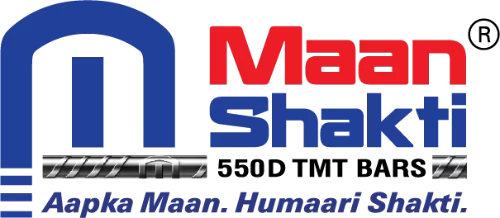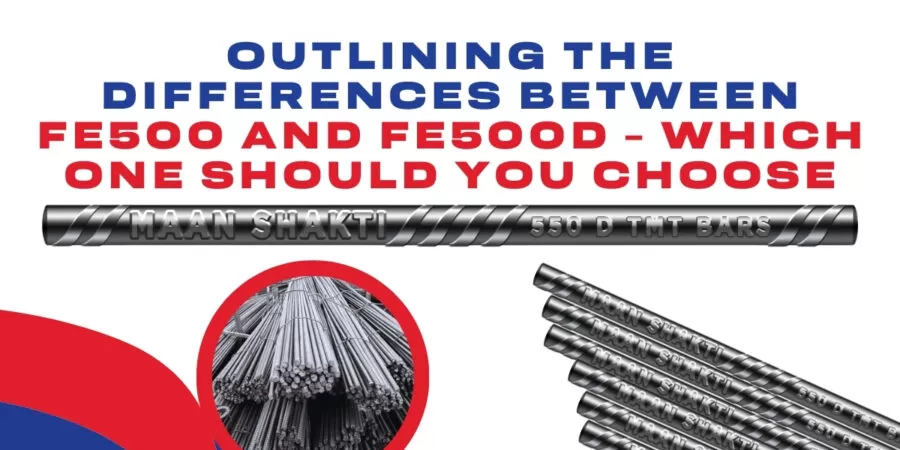Reinforced concrete is used in construction for a lot of purposes. Owing to its strength and durability, steel reinforcement is used in the concrete. Selecting the steel grade is crucial, and it impacts the cost and performance of any construction structure. Among the common steel grades, the Fe500 and Fe500D steel bars are used.
If you are in the construction industry, you might require working with any of these bars. On that note, this post outlines the differences, applications, and benefits of these TMT bars. So, let’s check them out in the following points.
An Overview of the Fe500 and Fe500D TMT Bars
Did you know that Fe500 and Fe500D TMT bars are the go-to choices for contractors, constructors, and builders?
Considering the Fe 550 TMT bars, these bars are ideal for high-rising buildings and other structures that need to bear a lot of weight. The ‘Fe’ here means the iron content present in the bar. On the other hand, the 550 is the bar’s minimum yield strength. The Fe 550 TMT bars have better tensile strength compared to the predecessors.
The “D” in the Fe 550D TMT bars indicates improved ductility. Now, what do you mean by ductility? Simply put, it’s the property that lets a material deform under tensile stress prior to fracturing.
Fe 500D bars provide flexibility. So, they are ideal for developing structures with high seismic movement.
The construction-grade TMT bars are in high demand. Presently, the more ductile 500D/550D grade steel bars are used in the construction industry. Because of more ductility, these TMT bars are suitable for construction since they make the structure more stable and stronger.
Top Advantages of Fe500 and Fe500D TMT Bars
The Fe500 TMT bars have high yield strength, which makes them excellent for large buildings. It provides excellent tensile strength and offers better structures. It can support high-rise projects and larger buildings. Like other TMT bars, the Fe500 variant is also corrosion-resistant.
Fe500D bars offer better tensile strength and yield than the Fe500 bars. Thus, they are excellent for heavier structures such as towers, dams, and flyovers (to mention a few). The Fe500D bars offer high flexibility that can withstand seismic activities. They are a cost-saving variant compared to the 500 grades.
Undertaking any project using Fe500D TMT bars needs fewer bars, so it ultimately reduces labour expenses. Altogether, it offers high weldability and remains unaffected during any temperature fluctuation, providing better durability. These bars are also corrosion-resistant.
Top Applications of FE500 – Where Are These Bars Used?
The Fe500 TMT bars are the standard option used for various construction purposes. These TMT bars have excellent stability and can keep the structure unaffected during earthquakes or any other natural calamities. They can be used for constructing multi-storeyed buildings, private buildings, and other business complexes.
Top Applications of FE500D – Purposes of These Bars
Fe500D TMT bars have an excellent tensile strength that makes them appropriate for various construction projects. The Fe500D grade TMT bars are used for various structures that endure tremendous weight. They are an excellent option for underground projects such as basements, beachfront properties, marine projects, etc. Altogether, these bars have flexibility and ductility as per the IS 1786.
Difference between Fe500 and Fe500D Considering Various Parameters
The following are the differences that you need to read considering the Fe500 and Fe500D:
Mechanical Properties
Both the various are manufactured using the thermomechanical treatment. So, they have the same yield strength (500). Nonetheless, they have different tensile stress and elongation percentages.
Considering the Fe500D variant, it has a high elongation capacity. On the other hand, the Fe500 TMT bars have a lower elongation capacity. That means both grades start deforming at similar rates and return to their original structure after the stress is removed. The breaking points of these bars are different. The Fe500D variant has a high breaking point compared to the Fe500 variant.
Chemical Composition
Another significant difference between Fe500D and Fe500 lies in the chemical composition. The Fe500 consists of a high amount of carbon, phosphorus, and sulphur. Fe500D has a lower percentage of the chemicals, so they are more flexible. Thus, these bars can withstand higher temperature fluctuations. The Fe500D is recommended in areas where there are more seismic activities and unforeseen weather changes.
On the other hand, the Fe500 variant is brittle and may break or crack during sudden changes in temperature. If you are planning to buy TMT bars, you must discuss your requirements with the best TMT bar manufacturers. Then, you can easily buy the best TMT bars according to your preferences and requirements.
Wrapping up
It is imperative to get in touch with a TMT bar manufacturer before you buy these bars at wholesale rates. Look for a qualified TMT manufacturer who can assess your requirements and help you make a well-informed decision.


Leave a Reply